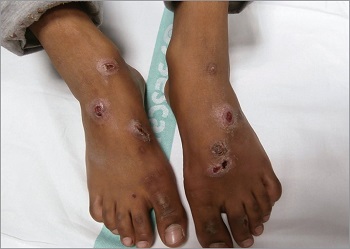Corynebacterium diphtheriae - Pathogenesis, Clinical syndrome, Respiratory Diptheria, Cutaneous Diphtheria
Pathogenesis of Corynebacterium diphtheriae
Corynebacterium diphtheriae enters the body through the upper respiratory tract (URT) but also enters through the skin, the genital tract, or the eye.
Infection begins with the adherence of bacteria at the infected site. Initially, a lesion occurs in the tonsils and oropharynx. From this site, it may spread to the nasopharynx, larynx, and trachea. Along with rapid multiplication, and lesion formation, they also secrete exotoxin (ie. diphtheria toxin). These toxins cause necrosis of the cells in that area.
Exudate inflammatory response is obtained which leads to the accumulation of RBC, necrotic cells, bacteria, fibrin, and lymphocytes. The combination of cell debris and exudative inflammatory response results in the formation of the pseudomembrane.
The pseudomembrane of Diptheria is thick, leathery, grayish-blue, or white. It adheres very tenaciously to the underlying mucosa. The membrane may spread down to the bronchial tree causing respiratory tract obstruction and dyspnea (shortness of breath).
The growth of Corynebacterium diphtheriae is restricted to the oral cavity. But toxins as absorbed from the site of the pseudomembrane causing toxemia and the systemic manifestation of diphtheria.
The toxin binds to specific receptors present on susceptible cells entered by receptor-medicated endocytosis. Ultimately, all host cells' EF-2 molecule is inactivated leading to cell death. The cell death clinically manifests as a necrotic lesion of diphtheria.
Clinical syndrome/manifestation of Corynebacterium diphtheriae
Clinical syndrome/manifestation of Corynebacterium diphtheriae depends upon the immune status of the patient, the virulence of bacteria, and the site of infection. The two important syndromes include respiratory diphtheria and cutaneous diphtheria.
Respiratory Diptheria
Incubation period of respiratory diphtheria is 2-5 days
initial symptom: sore throat
fever usually lower than 102°F, malaise, dysphasia (difficulty in swallowing), headache
marked edema of tonsil, vulva, submandibular region and anterior neck
complication: myocarditis, heart failure, circulatory collapse, atrioventricular blocks, paralysis of the soft palate

Fig: Cutaneous diphtheria (Source: CDC)
Cutaneous diphtheria
cutaneous diphtheria is generally caused by non-toxigenic strains
characterized by a non-healing ulcer with a gray-brown membrane
may occur at one or more sites
extremities are affected more than the trunk or head